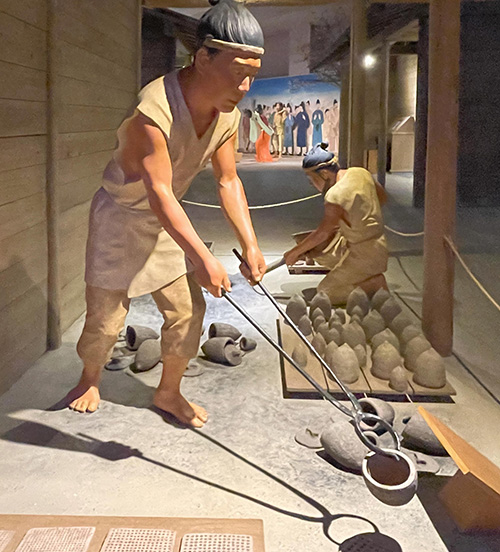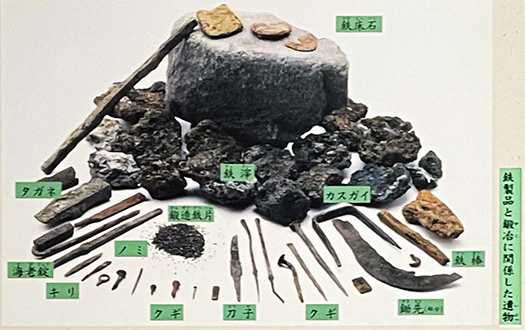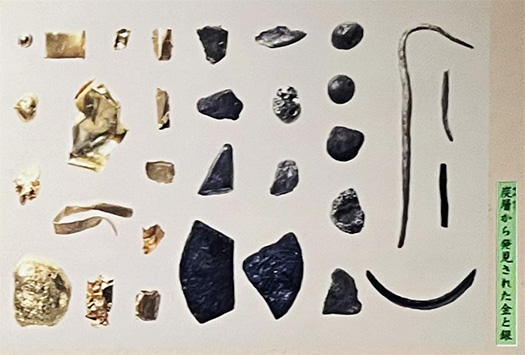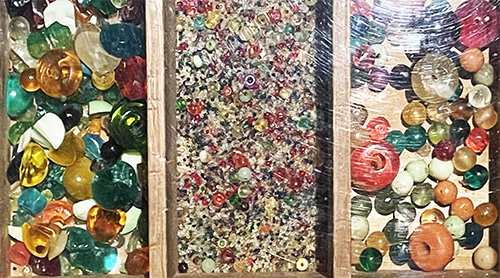


きのうは飛鳥大仏という具体的な金属加工芸術品とその生産を考えた。
文明が進歩発展していくということは
めずらしきもの、キラキラしたるものが起爆力として先導していく。
日本国家の始原期・飛鳥の時代において「近代化思想」は仏教が先導役。
八百万の自然崇拝型の民のこころに「刺さる」ものとして
極限的には仏像であるとか、金属加工物が果たした役割は計り知れない。
列島各地域に八百万として存在した地域権力に対して
中央権力機構としてかれらを支配し服従させるのに、金属加工の技術力は
即物的なパワーとして機能したに違いない。
各地域の権力者にしても、自らの正統性を誇示するには
中央王権との強固な結びつきを目にもあきらかにすることは
必需的な動機形成だったことだろう。
写真は池工房遺跡の上に建つ奈良県立万葉万葉文化館展示から。
飛鳥池工房遺跡からは金の粒と金箔、銀片などと
金や銀を溶かしたとみられる坩堝が見つかり金銀の加工が確認された。
玉とされた「ガラス」類も出土している。

出土状況から多量の金銀の扱いが推定される。
「銀も黄金も玉もなにせむに、勝れる宝、子に及〜しかめやも」
有名な山上憶良の歌は飛鳥で身近に生産される工程を見ていた証拠か。
当時金は国内からは産出されず、朝鮮を経てもたらされていた。
銀については国産の可能性もある。
日本で鉄器は弥生時代から使われ始めた。大陸・半島からの伝来。
古墳時代には全国的に普及していた。
水田耕作は最初期は「芦原の中津」を探して造作していったのだろうけれど、
徐々にそうした自然状態の最適地は探し尽くされ、
その後は鉄器による開墾と土木が不可欠な土地に用地を拡大したのだろう。
そうするとより強力なスキ・クワの類が必需品化していった。
飛鳥池工房での鉄製品のなかでいちばん多く出土するのはクギ。
ほかにはカスガイ、ノミ、タガネ、刀子など建築の基本材料。
それまでの木繊維での編み上げ結束工法の限界を超える接合部の
補強金物の出現で建築の大型化、多層化が実現していった。
列島内で鉄が生産されなかったことから、朝鮮半島での利権維持が
列島王権の不可欠な「生命線」になって、やがて白村江出兵のような
直接的関与の伏線動機になっていく。
その後、山陰地方で鉄鉱山が開発されるようになって
全国各地で鉱脈が発見され、同時に海に囲まれた大量の森林資源が
鉄生産に不可欠なバイオマス資源として活用されていく。以降、
江戸末期までにはほぼ全国の山は「ハゲ山」と化すほどに開発された。
江戸幕府は頻繁に「留め山」のような森林保護令を発している。
結局はこうした資源エネルギーの推移が日本史の主役とも言える。
このことは人類史全般でもまったく同様。
列島社会では建築は石ではなく木造で発展していくことになるが、
奈良期の建築の大型化、大量化は資源の枯渇を招き
鎌倉初期の奈良大仏殿再建工事では山口県地方まで良材を求めたりしている。
飛鳥池工房はこうした日本の金属加工・工業そして建築の起点として
始原期の状況を生々しく伝えてくれている。
English version⬇
Asuka Historical Testimony – 5] “Blacksmithing Workshop,” a Technological Force at the Beginning of the Nation
Metalworking “industrialization” was essential for a nation to grow into an archipelagic society. Resources and energy are the universal historical factors of mankind. …
Yesterday, I considered the Asuka Great Buddha, a concrete metalworking artifact and its production.
The progress and development of a civilization is
The progress and development of a civilization is driven by something unusual and sparkling as a catalyst.
In the Asuka period, the original period of the Japanese nation, Buddhism played a leading role in the “modernization idea.
Buddhism was the one that “stuck” in the hearts of the 8 million nature-worshipping peoples.
In the extreme, the role played by Buddhist statues and metalwork is immeasurable.
In contrast to the local power that existed in each region of the archipelago as eight million people, the central power structure
The technical power of metalworking functioned as an immediate power to control and subjugate them as a central power structure.
The metalworking technology must have functioned as an immediate power to control and subjugate them as a central power structure.
In order to show off their legitimacy, the local authorities had to
It was a necessary incentive for each regional power to make its strong ties to the central
This must have been a necessary motive.
The photo is from the exhibition at the Nara Prefecture Complex of Manyo Man’yo Culture Museum, which stands on top of the Ikegakobo site.
From the Asuka Pond Studio site, gold grains, gold leaf, silver fragments, and other items that appear to have been melted down into gold and silver were found.
The crucible in which the gold and silver were melted was found at the Asuka Pond Studio site, confirming the processing of gold and silver.
Glass, which was thought to be jade, was also excavated.
The excavation of the crucibles suggests that a large amount of gold and silver was handled.
What is silver, gold, and jade, but a treasure so great, that it may be passed on to a child?
This famous poem by Yamakami Imura may be evidence that he was familiar with the production process in Asuka.
At that time, gold was not produced domestically, but was brought to Japan via Korea.
Silver may have been domestically produced.
Ironware began to be used in Japan from the Yayoi period. They were introduced from the continent and peninsula.
They were widespread throughout the country during the Kofun period.
Paddy field cultivation probably started in the beginning by looking for “Ashiwara no Nakatsu” (the middle of Ashiwara).
Gradually, the best sites in such natural conditions were exhausted.
After that, the land was expanded to areas where cultivation and civil engineering with iron tools were indispensable.
As they did so, more powerful skis and spears became a necessity.
Among the iron artifacts excavated at the Asukaike workshop, the most frequently found item was a spike.
Other basic building materials include kasugai, chisels, taganes, and sword hammers.
The emergence of reinforcing hardware for joints, which exceeded the limits of the previous method of weaving and binding wood fibers, led to the development of the construction method.
The emergence of reinforcing hardware for joints that exceeded the limits of the wood-fiber weave-and-bind method led to the realization of larger, multi-layered buildings.
Since iron was not produced in the archipelago, the maintenance of interests on the Korean peninsula was an essential “life force” for the kingship of the archipelago.
This became an indispensable “lifeline” for the royalty in the archipelago, and eventually became a foreshadowing motive for direct involvement, such as the invasion of the Hakuchon River.
This became a foreshadowing motive for direct involvement.
Later, iron mines began to be developed in the San’in region, and
The discovery of mineral deposits in various parts of the country, and at the same time, the large amount of forest resources surrounded by the sea
biomass resources essential for iron production. Since then
By the end of the Edo period, almost all the mountains in the country were developed to the extent that they were turned into “bald mountains.
The Edo Shogunate frequently issued decrees to protect forests, such as the “Maeyama (mountain retaining)” ordinance.
In the end, these resource-energy transitions can be said to have played a leading role in Japanese history.
The same is true of human history in general.
In archipelagic societies, architecture developed not from stone but from wood.
However, the increasing size and mass production of architecture during the Nara period led to the depletion of natural resources, and the development of wooden architecture in the early Kamakura period led to the development of the Great Buddha in Nara.
The large size and mass production of buildings during the Nara period (710-794) led to the depletion of resources, and the reconstruction of the Great Buddha Hall in Nara in the early Kamakura period (1185-1333) required the use of timber from Yamaguchi Prefecture.
Asuka Ike Kobo is the starting point of metalworking, industry, and architecture in Japan.
The Asuka Pond Studio vividly conveys the conditions of the early days of metalworking, industry, and architecture in Japan.
Posted on 6月 24th, 2022 by 三木 奎吾
Filed under: 日本社会・文化研究, 歴史探訪







コメントを投稿
「※誹謗中傷や、悪意のある書き込み、営利目的などのコメントを防ぐために、投稿された全てのコメントは一時的に保留されますのでご了承ください。」
You must be logged in to post a comment.